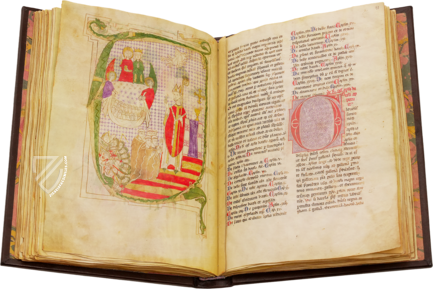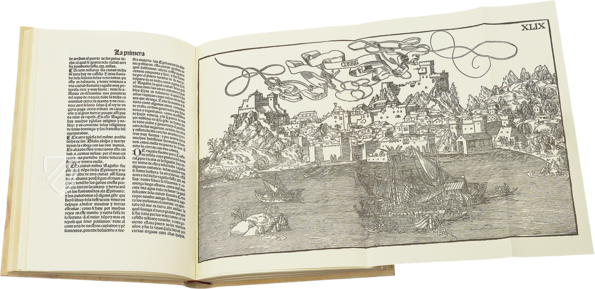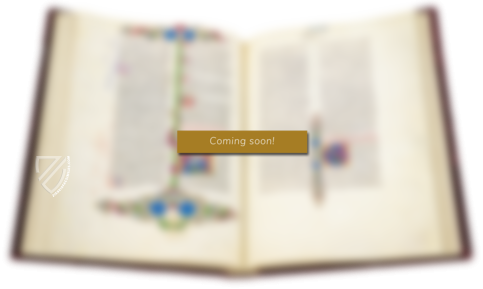Miracles of Saint James the Apostle and the Catholic Monarchs' safe-conduct
(1,000€ - 3,000€)
A pilgrimage to the tomb of St. James in Spanish Santiago de Compostela is among the greatest experiences in the life of a Christian today. In the 15th century, this pilgrimage to the north-westernmost corner of Spain was a special adventure. Many dangers awaited them on the way to the tomb of St. James. The Safe Conduct of the Catholic Monarch served as a valuable letter of safe conduct for the Christian pilgrims. Further information for the pilgrim’s journey was offered by the famous 12th century Libre Sancti Iacobi (also known as the Codex Calixtinus), which served the pilgrims as a valuable guidebook in a 15th century Spanish translation. This pilgrim’s guide, along with Safe Conduct of the Catholic Monarch, offers a direct glimpse into the charm of a 15th century pilgrimage to Santiago de Compostela!
Miracles of St. James and Safe Conduct of the Catholic Monarchs
A pilgrimage to the tomb of St. James in Spanish Santiago de Compostela is among the greatest experiences in the life of a Christian today. In the 15th century, this pilgrimage to the north-westernmost corner of Spain was a special adventure. Many dangers awaited them on the way to the tomb of St. James. The Safe Conduct of the Catholic Monarch served as a valuable letter of safe conduct for the Christian pilgrims. Further information for the pilgrim’s journey was offered by the famous 12th century Libre Sancti Iacobi (also known as the Codex Calixtinus)**, which served the pilgrims as a valuable guidebook in a 15th century Spanish translation. This pilgrim’s guide, along with the Safe Conduct of the Catholic Monarch, offers a direct glimpse into the charm of a 15th century pilgrimage to Santiago de Compostela!
A Dangerous Journey
Since at least the 12th century, the pilgrimage to the tomb of St. James in Spanish Santiago de Compostela belonged among the greatest experiences in the life of a Christian. That the way of the pilgrims was not always easy or safe is attested to by the so-called charters of safe conduct. With these letters of safe passage, which identified one as a pilgrim, it was possible to move through foreign territories unmolested. A particularly significant specimen of a letter of safe conduct is stored today in the archives of the Santiago de Compostela Cathedral: Safe Conduct of the Catholic Monarch.
Pilgrims under the Protection of the Kings
This pass or letter of safe conduct, known as Salvoconducto de los Reyes Católicos a todos los cristianos, extranjeros o nacionales, que acudan en peregrinación a Santiago, guaranteed a safe journey to the pilgrims under the protection of the kings through the not-always safe regions along the Way of Saint James. Thus the Christian pilgrims were recognized and treated as such, which also lends the letter of safe passage another function as an important political guide book. The exceedingly valuable document is dated the 16th of January, 1479. In gorgeous, evenly and tightly written script, it represents an important piece of evidence for importance the pilgrimage route to Santiago de Compostela already had in the 15th century. Signed by Isabella of Castile and Ferdinand of Aragon, the so-called Catholic monarchs, the letter of safe conduct is concurrently an inestimable piece of the history of this important period of the Spanish Kingdom.
A Medieval Travel Guide
This significant certificate of the pilgrimages in the 15th century is accompanied by a wonderful manuscript. A small booklet, inconspicuously bound in vellum, conceals a true treasure within: a Spanish translation of the famous Liber Sancti Iacobi! This significant work from the 12th century is also known as the Calixtinus Codex, because its authorship was falsely attributed to Pope Calixtus II (1119–1124). The Liber Sancti Iacobi represents the most important pilgrim’s guide for a pilgrimage to Santiago de Compostela. Divided into five parts, the manuscript contains inter alia the miracles of St. James, the writing of the so-called Pseudo-Turpin Chronicle – a legend concerning Charlemagne’s campaign against the Moors and the opening of the way to Santiago – and a pilgrim’s guide with explanations concerning the history of the city and its churches as well as the life and legends of the apostle.
A Truly Historic Treasure
This codex became the foundation for the cult of St. James and the pilgrimage to Santiago de Compostela. The unique specimen of this document, which is found today in the Spanish National Library, was translated into the Galician language in the 15th century. The booklet with 64 tightly-written pages could thus serve Spanish pilgrims as a valuable guidebook on their journey. The manuscript, adorned with emphasized headings and initials in brown, red, and blue ink, represents an exceptional 15th century guidebook. Together with the document of The Safe Conduct of the Catholic Monarchs, the manuscript offers the unique opportunity to set oneself back in the 15th century; in this time when a pilgrimage to Santiago de Compostela represented an unsurpassable adventure – as it still does today.
Codicology
- Alternative Titles
- Milagros de Santiago Apóstol y Salvoconducto de los Reyes Católicos
Wunder von St. James und sicheres Geleit der katholischen Könige - Origin
- Spain
- Date
- 15th century
- Epochs
- Style
- Genre
- Language
#1 Milagros de Santiago Apóstol y Salvoconducto de los Reyes Católicos
(1,000€ - 3,000€)
- Treatises / Secular Books
- Apocalypses / Beatus
- Astronomy / Astrology
- Bestiaries
- Bibles / Gospels
- Chronicles / History / Law
- Geography / Maps
- Saints' Lives
- Islam / Oriental
- Judaism / Hebrew
- Single Leaf Collections
- Leonardo da Vinci
- Literature / Poetry
- Liturgical Manuscripts
- Medicine / Botany / Alchemy
- Music
- Mythology / Prophecies
- Psalters
- Other Religious Books
- Games / Hunting
- Private Devotion Books
- Other Genres
- Afghanistan
- Armenia
- Austria
- Belgium
- Belize
- Bosnia and Herzegovina
- China
- Colombia
- Costa Rica
- Croatia
- Cyprus
- Czech Republic
- Denmark
- Egypt
- El Salvador
- Ethiopia
- France
- Germany
- Greece
- Guatemala
- Honduras
- Hungary
- India
- Iran
- Iraq
- Israel
- Italy
- Japan
- Jordan
- Kazakhstan
- Kyrgyzstan
- Lebanon
- Liechtenstein
- Luxembourg
- Mexico
- Morocco
- Netherlands
- Palestine
- Panama
- Peru
- Poland
- Portugal
- Romania
- Russia
- Serbia
- Spain
- Sri Lanka
- Sweden
- Switzerland
- Syria
- Tajikistan
- Turkey
- Turkmenistan
- Ukraine
- United Kingdom
- United States
- Uzbekistan
- Vatican City
- A. Oosthoek, van Holkema & Warendorf
- Aboca Museum
- Ajuntament de Valencia
- Akademie Verlag
- Akademische Druck- u. Verlagsanstalt (ADEVA)
- Aldo Ausilio Editore - Bottega d’Erasmo
- Alecto Historical Editions
- Alkuin Verlag
- Almqvist & Wiksell
- Amilcare Pizzi
- Andreas & Andreas Verlagsbuchhandlung
- Archa 90
- Archiv Verlag
- Archivi Edizioni
- Arnold Verlag
- ARS
- Ars Magna
- ArtCodex
- AyN Ediciones
- Azimuth Editions
- Badenia Verlag
- Bärenreiter-Verlag
- Belser Verlag
- Belser Verlag / WK Wertkontor
- Benziger Verlag
- Bernardinum Wydawnictwo
- BiblioGemma
- Biblioteca Apostolica Vaticana (Vaticanstadt, Vaticanstadt)
- Bibliotheca Palatina Faksimile Verlag
- Bibliotheca Rara
- Boydell & Brewer
- Bramante Edizioni
- Bredius Genootschap
- Brepols Publishers
- British Library
- C. Weckesser
- Caixa Catalunya
- Canesi
- CAPSA, Ars Scriptoria
- Caratzas Brothers, Publishers
- Carus Verlag
- Casamassima Libri
- Centrum Cartographie Verlag GmbH
- Chavane Verlag
- Christian Brandstätter Verlag
- Circulo Cientifico
- Club Bibliófilo Versol
- Club du Livre
- CM Editores
- Collegium Graphicum
- Collezione Apocrifa Da Vinci
- Comissão Nacional para as Comemorações dos Descobrimentos Portugueses
- Coron Verlag
- Corvina
- CTHS
- D. S. Brewer
- Damon
- De Agostini/UTET
- De Nederlandsche Boekhandel
- De Schutter
- Deuschle & Stemmle
- Deutscher Verlag für Kunstwissenschaft
- DIAMM
- Droz
- E. Schreiber Graphische Kunstanstalten
- Ediciones Boreal
- Ediciones Grial
- Ediclube
- Edições Inapa
- Edilan
- Editalia
- Edition Deuschle
- Edition Georg Popp
- Edition Leipzig
- Edition Libri Illustri
- Editiones Reales Sitios S. L.
- Éditions de l'Oiseau Lyre
- Editions Medicina Rara
- Editorial Casariego
- Editorial Mintzoa
- Editrice Antenore
- Editrice Velar
- Edizioni Edison
- Egeria, S.L.
- Eikon Editores
- Electa
- Emery Walker Limited
- Enciclopèdia Catalana
- Eos-Verlag
- Ephesus Publishing
- Ernst Battenberg
- Eugrammia Press
- Extraordinary Editions
- Fackelverlag
- Facsimila Art & Edition
- Facsimile Editions Ltd.
- Facsimilia Art & Edition Ebert KG
- Faksimile Verlag
- Feuermann Verlag
- Folger Shakespeare Library
- Franco Cosimo Panini Editore
- Friedrich Wittig Verlag
- Fundación Hullera Vasco-Leonesa
- G. Braziller
- Gabriele Mazzotta Editore
- Gebr. Mann Verlag
- Gesellschaft für graphische Industrie
- Getty Research Institute
- Giovanni Domenico de Rossi
- Giunti Editore
- Graffiti
- Grafica European Center of Fine Arts
- Guido Pressler
- Guillermo Blazquez
- Gustav Kiepenheuer
- H. N. Abrams
- Harrassowitz
- Harvard University Press
- Helikon
- Hendrickson Publishers
- Henning Oppermann
- Herder Verlag
- Hes & De Graaf Publishers
- Hoepli
- Holbein-Verlag
- Houghton Library
- Hugo Schmidt Verlag
- Idion Verlag
- Il Bulino, edizioni d'arte
- ILte
- Imago
- Insel Verlag
- Insel-Verlag Anton Kippenberger
- Instituto de Estudios Altoaragoneses
- Instituto Nacional de Antropología e Historia
- Introligatornia Budnik Jerzy
- Istituto dell'Enciclopedia Italiana - Treccani
- Istituto Ellenico di Studi Bizantini e Postbizantini
- Istituto Geografico De Agostini
- Istituto Poligrafico e Zecca dello Stato
- Italarte Art Establishments
- Jan Thorbecke Verlag
- Johnson Reprint Corporation
- Josef Stocker
- Josef Stocker-Schmid
- Jugoslavija
- Karl W. Hiersemann
- Kasper Straube
- Kaydeda Ediciones
- Kindler Verlag / Coron Verlag
- Kodansha International Ltd.
- Konrad Kölbl Verlag
- Kurt Wolff Verlag
- La Liberia dello Stato
- La Linea Editrice
- La Meta Editore
- Lambert Schneider
- Landeskreditbank Baden-Württemberg
- Leo S. Olschki
- Les Incunables
- Liber Artis
- Library of Congress
- Libreria Musicale Italiana
- Lichtdruck
- Lito Immagine Editore
- Lumen Artis
- Lund Humphries
- M. Moleiro Editor
- Maison des Sciences de l'homme et de la société de Poitiers
- Manuscriptum
- Martinus Nijhoff
- Maruzen-Yushodo Co. Ltd.
- MASA
- Massada Publishers
- McGraw-Hill
- Metropolitan Museum of Art
- Militos
- Millennium Liber
- Müller & Schindler
- Nahar - Stavit
- Nahar and Steimatzky
- National Library of Wales
- Neri Pozza
- Nova Charta
- Oceanum Verlag
- Odeon
- Orbis Mediaevalis
- Orbis Pictus
- Österreichische Staatsdruckerei
- Oxford University Press
- Pageant Books
- Parzellers Buchverlag
- Patrimonio Ediciones
- Pattloch Verlag
- PIAF
- Pieper Verlag
- Plon-Nourrit et cie
- Poligrafiche Bolis
- Presses Universitaires de Strasbourg
- Prestel Verlag
- Princeton University Press
- Prisma Verlag
- Priuli & Verlucca, editori
- Pro Sport Verlag
- Propyläen Verlag
- Pytheas Books
- Quaternio Verlag Luzern
- Reales Sitios
- Recht-Verlag
- Reichert Verlag
- Reichsdruckerei
- Reprint Verlag
- Riehn & Reusch
- Roberto Vattori Editore
- Rosenkilde and Bagger
- Roxburghe Club
- Salerno Editrice
- Saltellus Press
- Sandoz
- Sarajevo Svjetlost
- Schöck ArtPrint Kft.
- Schulsinger Brothers
- Scolar Press
- Scrinium
- Scripta Maneant
- Scriptorium
- Shazar
- Siloé, arte y bibliofilia
- SISMEL - Edizioni del Galluzzo
- Sociedad Mexicana de Antropología
- Société des Bibliophiles & Iconophiles de Belgique
- Soncin Publishing
- Sorli Ediciones
- Stainer and Bell
- Studer
- Styria Verlag
- Sumptibus Pragopress
- Szegedi Tudomànyegyetem
- Taberna Libraria
- Tarshish Books
- Taschen
- Tempus Libri
- Testimonio Compañía Editorial
- Thames and Hudson
- The Clear Vue Publishing Partnership Limited
- The Facsimile Codex
- The Folio Society
- The Marquess of Normanby
- The Richard III and Yorkist History Trust
- Tip.Le.Co
- TouchArt
- TREC Publishing House
- TRI Publishing Co.
- Trident Editore
- Tuliba Collection
- Typis Regiae Officinae Polygraphicae
- Union Verlag Berlin
- Universidad de Granada
- University of California Press
- University of Chicago Press
- Urs Graf
- Vallecchi
- Van Wijnen
- VCH, Acta Humaniora
- VDI Verlag
- VEB Deutscher Verlag für Musik
- Verlag Anton Pustet / Andreas Verlag
- Verlag Bibliophile Drucke Josef Stocker
- Verlag der Münchner Drucke
- Verlag für Regionalgeschichte
- Verlag Styria
- Vicent Garcia Editores
- W. Turnowski Ltd.
- W. Turnowsky
- Waanders Printers
- Wiener Mechitharisten-Congregation (Wien, Österreich)
- Wissenschaftliche Buchgesellschaft
- Wissenschaftliche Verlagsgesellschaft
- Wydawnictwo Dolnoslaskie
- Xuntanza Editorial
- Zakład Narodowy
- Zollikofer AG











